Lavender leaves have been used for centuries in natural remedies. They have a history of over 2,500 years. Lavender leaves are great for relaxation, cooking, and even keeping pests away. With about 30 types of lavender, there are many ways to use them.
Lavender has been loved since ancient Egypt for its beauty and health benefits. It’s used in hair treatments, showing its power in growth and preventing loss. Lavender leaves can be used in cooking, hair care, or for aromatherapy. They are a natural remedy that fits into daily life.
Lavender leaves are calming and useful in cooking. They help with digestion and keep pests away. They are a key part of natural health and wellness. As we learn more about lavender leaves, they will keep being a favorite in gardens and homes.
Key Takeaways
- Lavender leaves have been used for at least 2,500 years for their medicinal and culinary properties.
- There are approximately 30 species of lavender, offering a range of possibilities for utilizing lavender leaves.
- Lavender leaves can be used to promote relaxation, enhance culinary creations, and repel pests.
- The recommended mixture ratio for hair treatment is 5 tablespoons of lavender-infused vinegar to 1 cup of water.
- Lavender leaves can be used in cooking, as a hair tonic, or in aromatherapy, making them a versatile natural remedy.
- Lavender leaves have been shown to promote hair growth, prevent hair loss, and alleviate digestive discomfort.
- Lavender leaves are a valuable resource for those seeking a more natural approach to health and wellness.
Understanding Lavender Leaves and Their Historical Significance
Lavender leaves have been used for over 2,500 years. They have been valued across many cultures. To buy lavender leaves today connects you to a long history. This history includes ancient Egypt, Greece, and Rome, where they were prized for their health, beauty, and taste.
The importance of lavender is clear in its wide use. It was used in ancient Egypt for mummification and in Greek and Roman medicine. For those interested in lavender, knowing its history adds to its appeal. Whether you use dried lavender leaves for tea or culinary lavender leaves in cooking, its past enriches its present value.
Lavender’s journey through time shows its adaptability and human interest in its benefits. It has moved from ancient medicine to today’s aromatherapy and cooking. Lavender remains a plant of great cultural and practical worth.
Identifying and Growing Lavender Plants
To enjoy lavender leaf tea and try out lavender leaf recipes, you need to grow the right lavender plant. There are over 400 types of lavender, each with its own look and needs. English lavender (Lavandula angustifolia) is a favorite for its toughness and beauty.
Lavender needs the right conditions to grow well. It likes cool, moist winters and hot, dry summers. For growing in pots, mix 1/3 sand, 1/3 topsoil, and 1/3 compost. This helps with drainage and keeps the plant healthy. Also, regular pruning keeps the plant bushy and full of flowers.
Here are some tips for growing lavender:
- Plant in sunny spots with good air flow
- Water less often to avoid root rot
- Prune after flowers to encourage new growth
- Add horticultural grit to the hole for better drainage
By following these tips and picking the right lavender, you can enjoy lavender leaf tea and try out different recipes. Growing lavender is rewarding, whether you’re new to gardening or have experience.
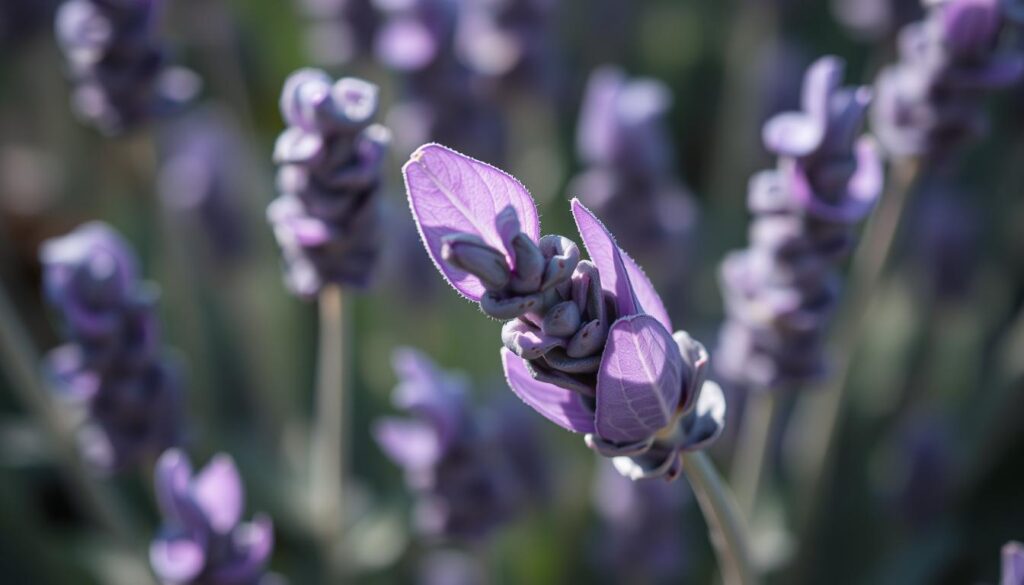
Lavender plants can live for about 15 years if cared for right. Some types can even handle temperatures as low as -10 degrees Fahrenheit. Knowing what your lavender needs ensures a good harvest and lets you use lavender leaves in many ways.
| Lavender Variety | Hardiness | Height |
|---|---|---|
| English Lavender | USDA Zone 5 | 1-3 feet |
| Spanish Lavender | USDA Zones 7-9 | 1-2 feet |
| French Lavender | USDA Zones 7-9 | 1-2 feet |
The Chemical Composition of Lavender Leaves
Lavender leaves have a complex mix of essential oils and active compounds. These elements are key to the lavender leaf health benefits and medicinal uses. Knowing what’s in lavender leaves helps us use them best.
Essential oils like linalool, linalyl acetate, and camphor are found in lavender leaves. These oils help fight bacteria and are used in medicines, cosmetics, and food.
Essential Oils Present in Leaves
- Linalool: 32-44%
- Linalyl acetate: 20-30%
- Camphor: 5-10%
- Caryophyllene: 5-10%
- Beta-phellandrene: 2-5%
- Eucalyptol: 2-5%
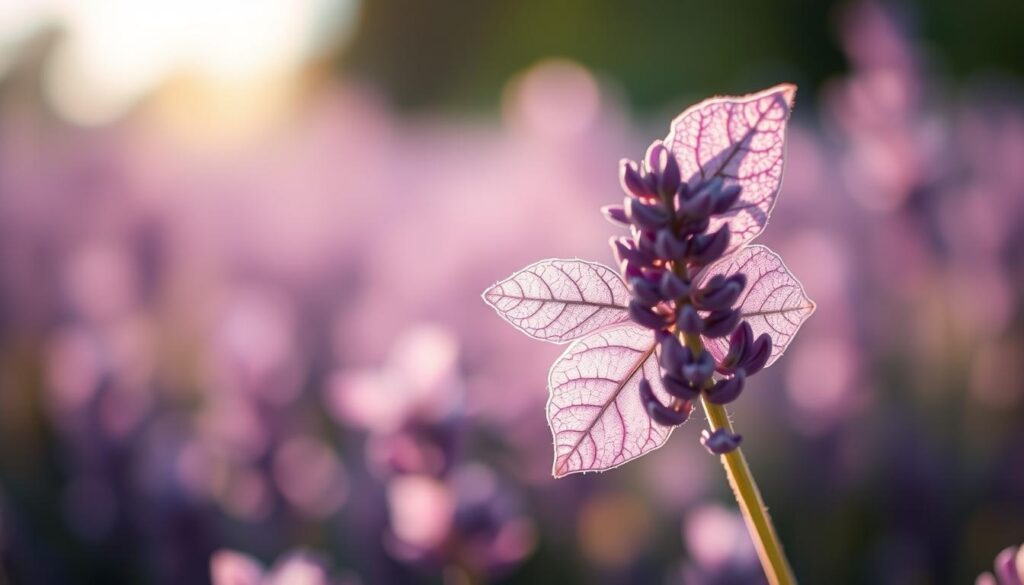
Active Compounds and Their Properties
The active compounds in lavender leaves have many benefits. They act as antioxidants, antiseptics, and anti-inflammatories. These properties make lavender leaves great for skincare, teas, and cooking.
| Compound | Property |
|---|---|
| Linalool | Antibacterial, antifungal |
| Linalyl acetate | Antibacterial, anti-inflammatory |
| Camphor | Antiseptic, anti-inflammatory |
Medicinal Properties of Lavender Leaves
Lavender leaves have many medicinal properties. They can help with calming effects and treating anxiety and insomnia. The essential oils and active compounds in lavender leaves offer several health benefits.
Some key health benefits of lavender leaves include:
- Improving sleep quality
- Reducing anxiety and stress
- Relieving pain and inflammation
- Supporting wound healing
Studies show lavender essential oil can reduce anxiety and improve sleep. For instance, a 2022 study found lavender helps sleep quality before insomnia starts. Also, a 2020 study showed lavender oil helps sleep in patients with serious illnesses.
Lavender leaves can be used in tea, aromatherapy, or as a topical application. But, it’s important to use lavender essential oil carefully. It can cause allergic reactions in some people. Always do a patch test before using lavender essential oil to avoid allergic reactions.
| Health Benefit | Study Findings |
|---|---|
| Improving sleep quality | A 2022 study found that lavender improved sleep quality in individuals before insomnia or other sleep disorders occurred. |
| Reducing anxiety and stress | A 2020 study indicated that lavender oil improved sleep in patients receiving palliative or end-of-life care. |
| Relieving pain and inflammation | A 2016 study found that women who smelled lavender for 30 minutes daily during the first three days of their menstrual cycle experienced less pain after two months. |
Harvesting and Preserving Lavender Leaves
Timing is key when harvesting lavender leaves. The best time is in the morning, after the dew has dried. This ensures the leaves keep their aromatic oils. For dried lavender leaves, cut the stems when the buds are colored and plump but not yet bloomed open. This usually happens in late May through June, depending on the climate and lavender variety.
To keep the leaves fresh, you have a few options. You can hang the bunches upside down in a cool, dark place. This helps keep the color and potency. Or, you can store culinary lavender leaves in airtight glass jars. Loose buds can go in zip-top plastic bags. Also, pruning at least one-third of an established plant each year helps with growth and a second bloom of lavender flowers.
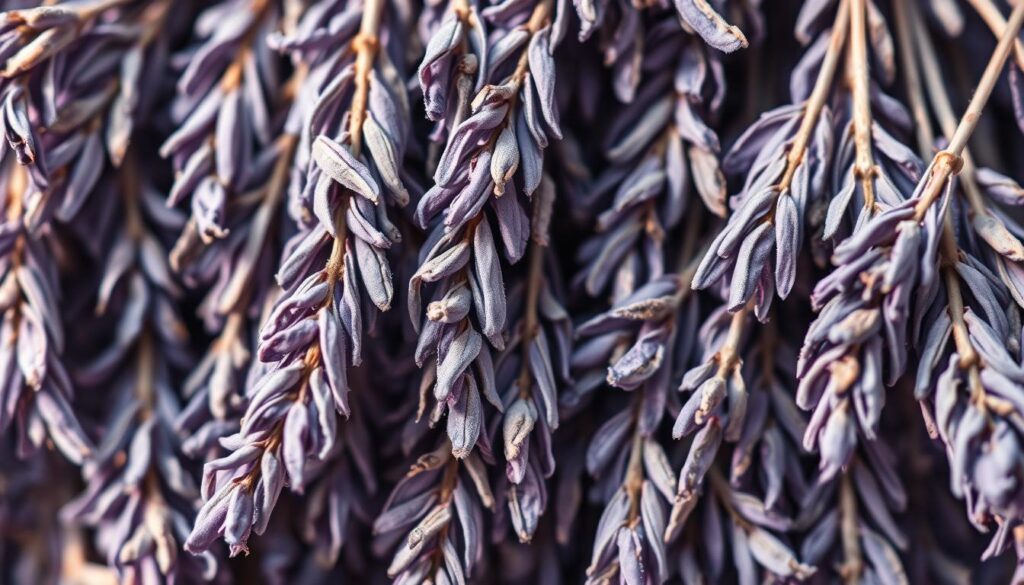
Here are some key considerations for harvesting and preserving lavender leaves:
- Harvest in the morning, after dew has dried, for maximum oil retention
- Cut stems when buds are colored and plump, but not yet bloomed open
- Hang bunches upside down in a cool, dark area to retain color and potency
- Use airtight glass jars for storing culinary lavender leaves
- Prune at least one-third of an established plant each year for optimal growth
By following these guidelines, you can ensure your lavender leaves are harvested and preserved well. This is true whether you’re using them for cooking or medicinal purposes.
| Method | Description |
|---|---|
| Hanging | Hanging bunches upside down in a cool, dark area to retain color and potency |
| Airtight Jars | Storing culinary lavender leaves in airtight glass jars to maintain freshness |
| Zip-top Bags | Storing loose buds in zip-top plastic bags for other uses |
Culinary Applications and Recipes
Lavender leaves are great in cooking and baking. They add flavor and aroma to many dishes. You can use them in lavender leaf recipes like lavender shortbread cookies and lemon bars.
Lavender leaves also make a soothing lavender leaf tea. You can drink it alone or mix it with lemonade or iced tea. To make it, steep dried leaves in hot water for 5-10 minutes, then strain and enjoy.
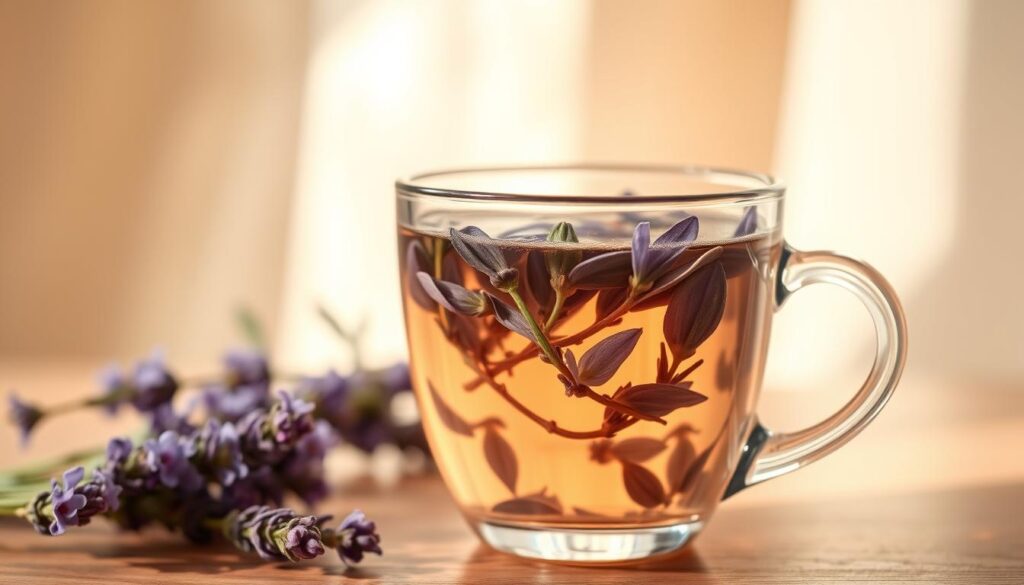
Lavender leaves are also good for making other drinks. You can make lavender syrup and lavender-infused milk. These can flavor your coffee, cocktails, and more. Some tasty lavender leaf recipes include:
- Lavender lemonade
- Lavender iced tea
- Lavender syrup
- Lavender-infused milk
Lavender leaves are versatile and flavorful. They’re perfect for making lavender leaf tea or adding flavor to your recipes. They’re a great choice for any culinary project.
Creating Natural Remedies with Lavender Leaves
Lavender leaves can be used to make teas, tinctures, and infusions. These remedies help with anxiety, insomnia, skin issues, and wounds. The lavender leaf benefits are many, and making these remedies can improve your health and wellbeing.
To make a lavender tincture, mix lavender leaves with olive or coconut oil. Let it steep for weeks. This tincture can soothe skin or help with anxiety. Here are some ways to use lavender leaves:
- Make a tea by steeping dried lavender leaves in hot water
- Create a tincture by combining lavender leaves with a carrier oil
- Use lavender leaves in cooking to add flavor and nutrition to dishes
When making natural remedies with lavender leaves, follow the right preparation and dosage. This ensures safety and effectiveness. By doing so, you can enjoy the many lavender leaf benefits and improve your health.
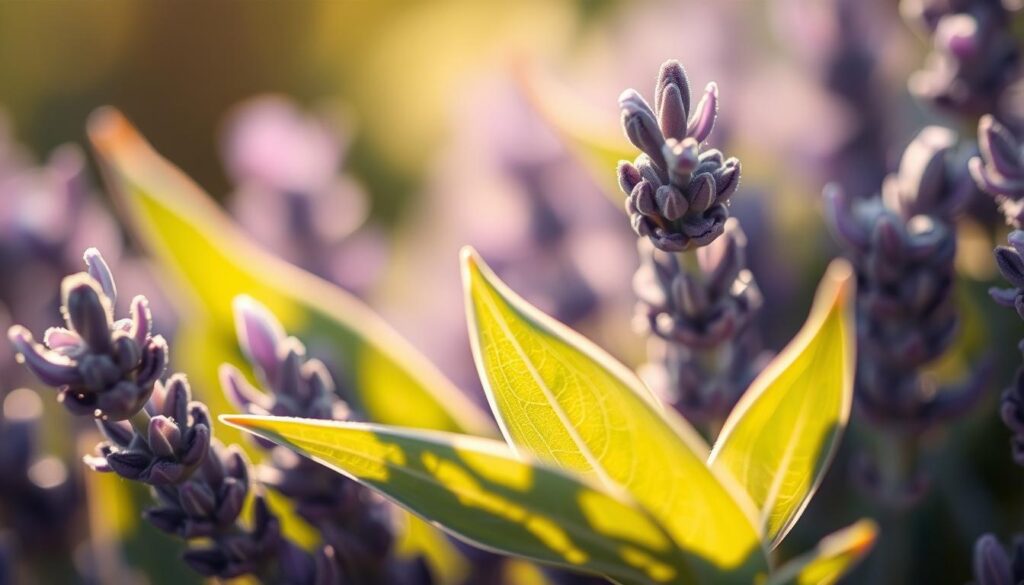
Lavender leaves are a valuable addition to natural remedies. They offer many benefits and uses that can improve your health and wellbeing.
| Remedy | Preparation | Usage |
|---|---|---|
| Lavender Tea | Steep dried lavender leaves in hot water | Drink to promote relaxation and reduce anxiety |
| Lavender Tincture | Combine lavender leaves with a carrier oil | Use topically to soothe skin irritations or ingest in small amounts to promote relaxation |
Aromatherapy and Essential Oil Extraction
Aromatherapy is a well-liked practice that uses essential oils, like those from lavender leaves, to help people relax and feel better. The lavender leaf health benefits are many, and using fresh lavender leaves can make aromatherapy even more effective.
Getting essential oils is key in aromatherapy, and there are many ways to do it. Steam distillation is a common method. It works by using steam to turn the plant material’s oils into vapor. This method is popular because it keeps the oils pure and their scent strong.
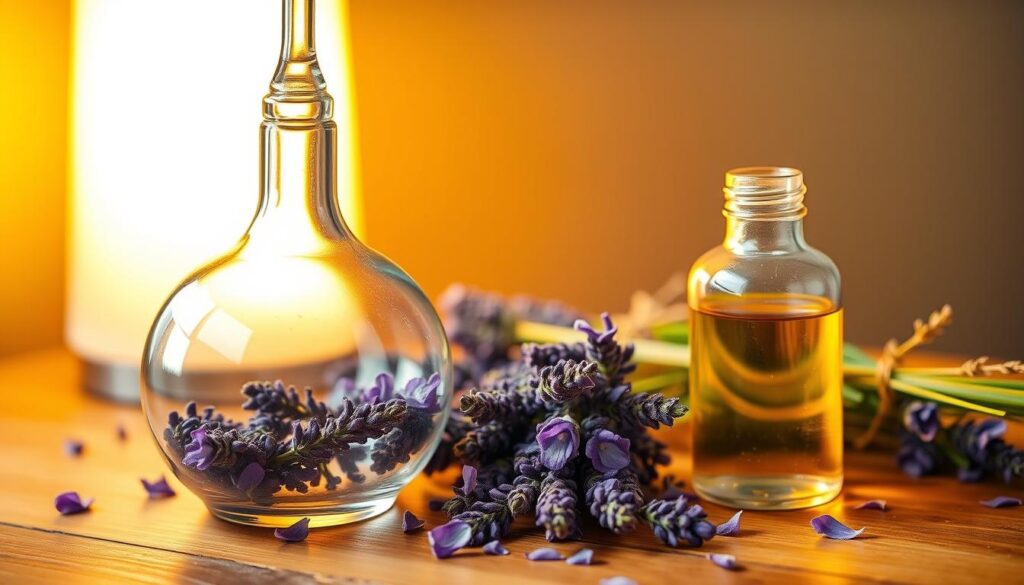
When making essential oils from fresh lavender leaves, timing and distillation method matter a lot. The quality of the plant material is also important. Knowing these details helps people make their own essential oils for aromatherapy and other uses.
It’s important to remember that lavender leaf health benefits are best when using high-quality essential oils. So, it’s key to pick a trusted supplier or to make the oils yourself using a good method.
Household Uses and Natural Cleaning
Lavender leaves are great for many household tasks. They can make natural cleaning products and air fresheners without harsh chemicals. Natural cleaning products made with lavender are soft on surfaces and the planet.
Here are some ways to use lavender leaves for cleaning:
- Make a lavender-infused vinegar to clean and remove smells.
- Add dried lavender to homemade floor cleaners for a nice scent.
- Use lavender leaf sachets to keep closets and vacuum bags smelling fresh.
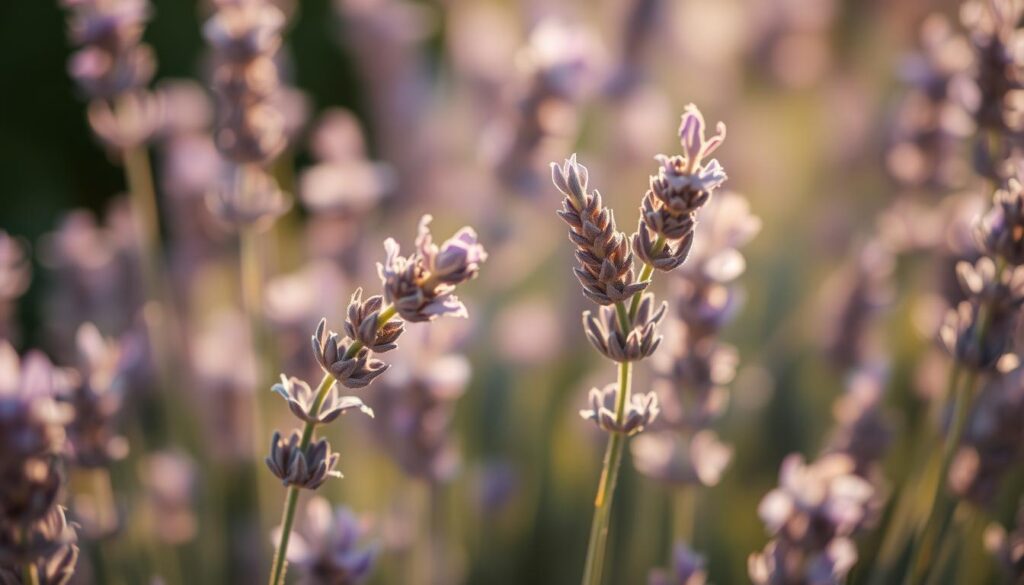
Lavender leaves are also good for cooking. They can make herbal salts and sugars that add flavor to food. Lavender’s natural antibacterial and antifungal properties are perfect for homemade cleaning.
| Lavender Leaf Use | Benefits |
|---|---|
| Natural Cleaning | Gentle on surfaces, environmentally friendly |
| Air Freshening | Eliminates odors, freshens air |
| Culinary Flavors | Enhances flavors, adds fragrance |
Potential Side Effects and Precautions
Lavender leaves are known for their health benefits, like lavender leaf health benefits. But, it’s important to know about possible side effects and precautions. Allergic reactions to lavender are rare, but they can happen. It’s key to know the signs and how to treat them.
Common allergic reactions include nausea, vomiting, and headaches after being exposed to lavender. Skin reactions like rashes, hives, and contact dermatitis can also occur. The severity of these symptoms depends on the amount of allergen and how long you’re exposed.
To avoid allergic reactions, use lavender leaves in moderation and follow the right usage guidelines. Over-the-counter treatments for lavender allergies include antihistamines, decongestants, and corticosteroids. Your healthcare provider will recommend the best treatment for you.
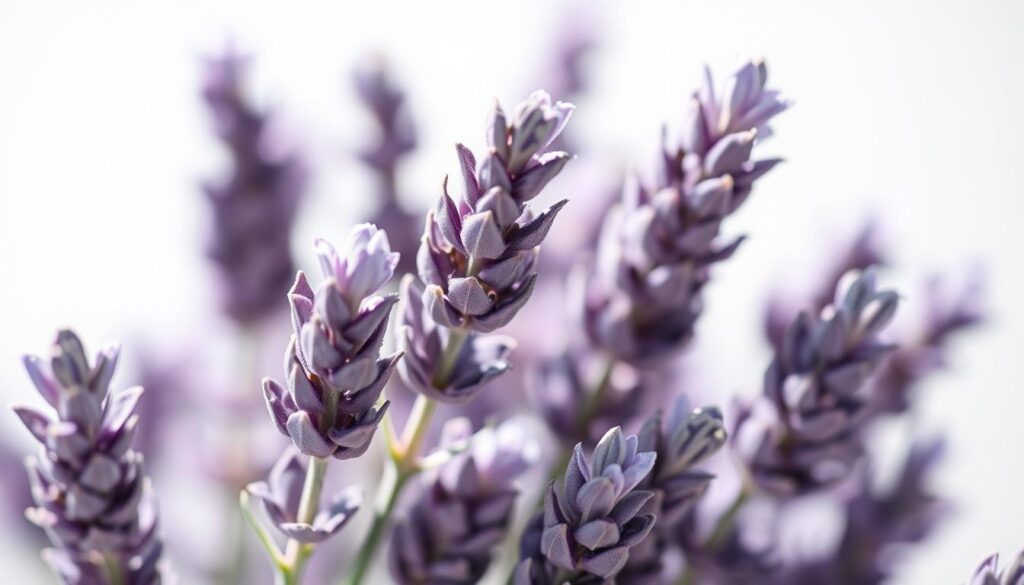
Also, taking steps to prevent allergic reactions is important. Avoid products with lavender and wear protective clothing or masks in places where lavender is used. By knowing the potential side effects and precautions, you can safely enjoy the health benefits of lavender leaves, including lavender leaf health benefits.
Sourcing Quality Lavender Leaves
When you want to buy lavender leaves, it’s key to focus on quality. Whether you need fresh or dried lavender leaves, getting them from a trusted source is vital. Here are some tips to find the best lavender leaves:
Start by looking for local farmers or online shops that focus on herbs. Look for varieties like Phenomenal® Lavender and Sensational!® Lavender. These are known for their special traits and disease resistance. When buying dried lavender leaves, check the packaging for moisture or damage. This can impact the leaves’ quality and strength.
Here are some things to think about when looking for lavender leaves:
- Find suppliers that share details about their lavender leaves’ origin and quality.
- Look for certifications like organic or non-GMO that match your needs.
- Read what others say and ask for advice to find a reliable seller.
By doing your homework and finding top-notch lavender leaves, you’ll get the most from their health and cooking benefits. Whether for personal use or business, picking a trustworthy supplier is crucial.
| Factor | Consideration |
|---|---|
| Origin | Look for suppliers that provide detailed information about the origin of their lavender leaves. |
| Certifications | Check for certifications, such as organic or non-GMO, that align with your preferences. |
| Reviews | Read reviews and ask for recommendations from other customers to ensure you are buying from a reputable source. |
Conclusion: Embracing the Power of Lavender Leaves in Daily Life
Lavender leaves are a true powerhouse in the natural world. They have a rich history and many uses. This plant has been loved by cultures around the world for over 2,500 years.
From ancient Egypt to today’s wellness movement, lavender leaves have shown their worth. They’ve been used for everything from embalming to calming scents.
By using lavender leaves in our daily lives, we open up a world of benefits. We can make our homes smell nice, use them for cooking, or enjoy their calming effects. There are so many ways to use this amazing plant.
Let’s keep learning from our ancestors and explore lavender leaves’ potential. By adding them to our daily lives, we can live more sustainably and healthily. Starting with one leaf, we can make a big difference in our well-being and the environment.
FAQ
What are the benefits of using lavender leaves?
Lavender leaves are known for their calming effects. They help treat anxiety and insomnia. The essential oils in them offer many health benefits.
How can lavender leaves be used in cooking and baking?
Lavender leaves add flavor and aroma to dishes. They are great in cooking and baking. Their uses in the kitchen are endless.
How can lavender leaves be used to create natural remedies?
Lavender leaves are used to make teas and tinctures. These remedies help treat various health issues. They are a popular choice for natural remedies.
What are the potential side effects and precautions when using lavender leaves?
Lavender leaves are generally safe but can cause allergic reactions. They might also interact with certain drugs. It’s important to know how to use them safely.
How can lavender leaves be used for household purposes?
Lavender leaves are great for cleaning and freshening the air. They help make natural cleaning products and air fresheners. This is a chemical-free way to keep your home clean.
How can I identify and grow lavender plants?
Knowing how to identify and grow lavender plants is key. There are many types of lavender, each with its own needs. Understanding these can help you grow them successfully.
How can I source quality lavender leaves?
Getting high-quality lavender leaves is important. Knowing how to buy and store them ensures you get the best. This is crucial for their effectiveness.
Source Links
- Lavender Leaves – Health Benefits, Uses and Important Facts – PotsandPans India – https://www.potsandpans.in/blogs/articles/lavender-leaves-health-benefits-uses-and-important-facts?srsltid=AfmBOorRyB4lfaxWqN0GyKHaTtsSRwRz7JPHS1AsLcnhEQK0rIsL1K5H
- Lavender Tea Benefits: The Beginners Guide – https://www.drinkteaa.com/blogs/healthy-lifestyle/lavender-tea-benefits?srsltid=AfmBOophcqjntDqq9itpb3svo4IxPOBpyg2CZo4O6BXEitxiD7KMiYHh
- 10 Advantages of Having a French Lavender – https://greg.app/french-lavender-benefits/
- Lavender: The Enchanting Herb for Healing, Magic, and Spiritual Wellness – https://medium.com/our-mystic-road-trip/lavender-the-enchanting-herb-for-healing-magic-and-spiritual-wellness-3414748ce939
- Lavender’s Meaning and Healing Benefits – https://thursd.com/articles/lavender-meaning
- Lavender Properties, Magickal Correspondences and Uses – Naturally Modern Witch – https://naturallymodernlife.com/lavender-properties-magickal-correspondences-and-uses/
- How to grow lavender – https://www.gardenersworld.com/how-to/grow-plants/how-to-grow-lavender/
- Types of Lavender: How to Choose the Best Lavender for Your Garden – https://www.monrovia.com/be-inspired/choose-the-best-lavender-for-your-garden.html?srsltid=AfmBOorD4bCMwd75DFK-ab0ulu6tpKfy09XlpJ1wEXsxqmB2BgnbmVB9
- How to Grow Lavender: The Complete Guide – https://www.almanac.com/plant/lavender
- Analysis of the Chemical Composition, Antimicrobial, and Antioxidant Qualities of Microwave and Supercritical CO2-Extracted Lavender Essential Oils Cultivated in a Hyperarid Region of Türkiye – https://www.mdpi.com/1420-3049/29/23/5605
- Comparative Study on the Chemical Composition and Biological Activities of the Essential Oils of Lavandula angustifolia and Lavandula x intermedia Cultivated in Lebanon – https://pmc.ncbi.nlm.nih.gov/articles/PMC11256343/
- Lavender: Health benefits and uses – https://www.medicalnewstoday.com/articles/265922
- 6 Lavender Benefits and How To Use It – https://health.clevelandclinic.org/health-benefits-of-lavender
- How To Prune, Harvest, And Dry Lavender – https://www.southernliving.com/garden/plants/how-to-harvest-lavender?srsltid=AfmBOoopBgIJxCpk2mtUYkysbhJUyKgTzOrbxd05NQRq2mScPQdSFnGq
- How to Grow and Harvest Lavender for Culinary Use – https://freckledcalifornian.com/2024/04/06/how-to-grow-and-harvest-lavender-for-culinary-use/
- 15 Creative Ways To Use Lavender In Your Cooking – Tasting Table – https://www.tastingtable.com/1512587/ways-to-use-lavender-in-cooking/
- How to Make Dried Lavender Simple Syrup • Heartbeet Kitchen – https://heartbeetkitchen.com/dried-lavender-simple-syrup/
- 🥗 Which Parts of Goodwin Creek Lavender Are Edible – https://greg.app/goodwin-creek-lavender-edible/
- Lavender Tincture + Uses – https://thenerdyfarmwife.com/lavender-tincture/
- How To Make Lavender Oil: A Step By Step Guide – https://lovelygreens.com/how-to-make-lavender-oil/
- Lavender Leaves – Health Benefits, Uses and Important Facts – PotsandPans India – https://www.potsandpans.in/blogs/articles/lavender-leaves-health-benefits-uses-and-important-facts?srsltid=AfmBOopWJ9446WvO4kdBiFUVxOpmKqyPO73HlvSxrANTHPCSWyv7Vh-o
- Lavender Essential Oil Production at NZ Lavender Farm: A Step-by-Step Guide – https://www.lavenderbackyard.co.nz/blogs/news/lavender-distilling?srsltid=AfmBOopabXnqpxsY5V3xc4otxeTrXRMD7Ituxkr4srxSNO7V0s41hULv
- Enhancing Essential Oil Extraction from Lavandin Grosso Flowers via Plasma Treatment – https://www.mdpi.com/1422-0067/25/4/2383
- MS-03-23-33.pmd – https://www.ijmfmap.in/pdf_vol10_1/vol_10_1_3.pdf
- 12 Cool Uses for Lavender Leaves You Need to Try! – https://homesteadingetc.com/uses-for-lavender-leaves/
- Harvesting and Using Them in Cooking and Cleaning – The Secret Garden Blog – https://secretgarden-online.info/lavender-leaves-harvesting-and-using-them-in-cooking-and-cleaning/
- Lavender: Benefits, Side Effects, and More – https://www.verywellhealth.com/lavender-benefits-7377185
- Lavender Allergy: Understanding Causes, Symptoms, and Treatments (2024) – https://www.wyndly.com/blogs/learn/lavender-allergy?srsltid=AfmBOorCKm9pBgBrXwEQXEz5J4hPoK93pFpaZs6ZCALttrw_hIvL-vOZ
- How Can You Tell If A Garden Lavender Is Dying? – https://greg.app/garden-lavender-problems/
- Which Lavender Plant is Best? — Plant and Bloom Design Studio – https://www.plantandbloomdesign.com/home/best-lavender-plants
- When to Harvest Lavender – A Gardener’s Guide – https://www.thecelticfarm.com/harvesting-lavender/
- The Journey of Lavender Scented Candles – https://lavender-life.com/blogs/news/the-journey-of-lavender-scented-candles?srsltid=AfmBOor34SU3ga9p_5Yn9XqicnBjy0Huz8i7qwxEdk6lPVjq6WNiCkk0
- Unwind and Relax: The Stress Relief Benefits of Lavender Neck Wraps – https://lavender-life.com/blogs/news/unwind-and-relax-the-stress-relief-benefits-of-lavender-neck-wraps?srsltid=AfmBOoq3YXgeruaZeUQJ_Y6d0rZCydX5vDwYdHxGcheJOoj_6ne8eYQM
- The Benefits of Incorporating Essential Oils into Your Daily Routine – Pure Natural Essential Oil, Manufacturer, Wholesaler & Supplier in India- Kanha Nature Oils – https://kanhanatureoils.com/blog/the-benefits-of-incorporating-essential-oils-into-your-daily-routine/?srsltid=AfmBOornc8zuE0JWhtUkmjoTlAqfO7NY4-JVn7H6bxhnLXANyrlmfdcr

